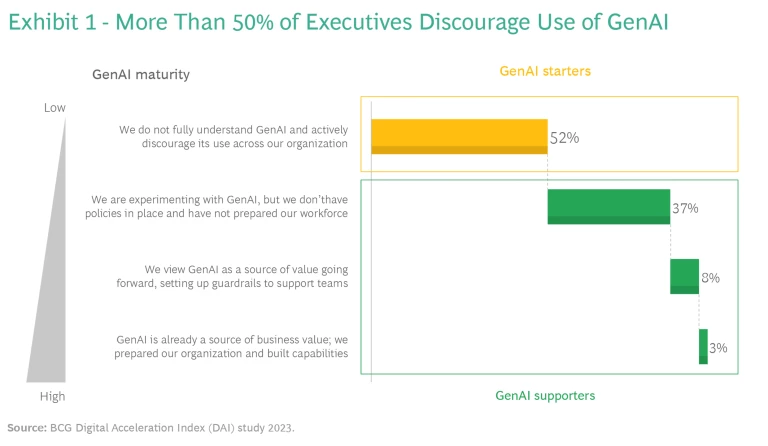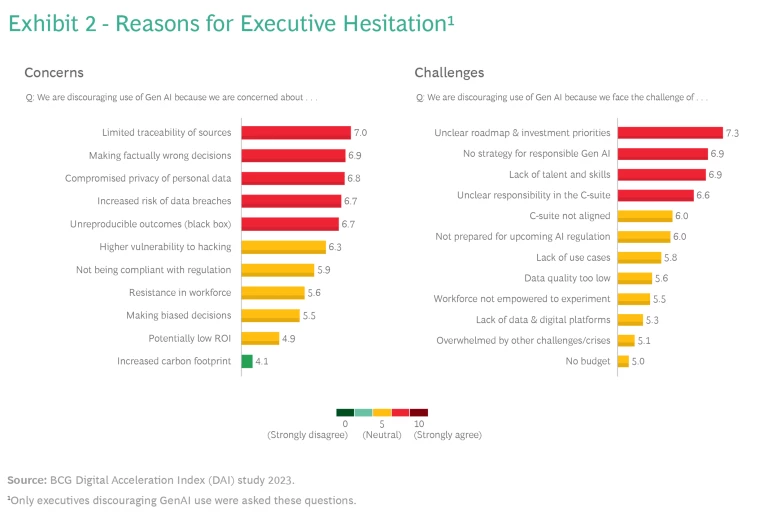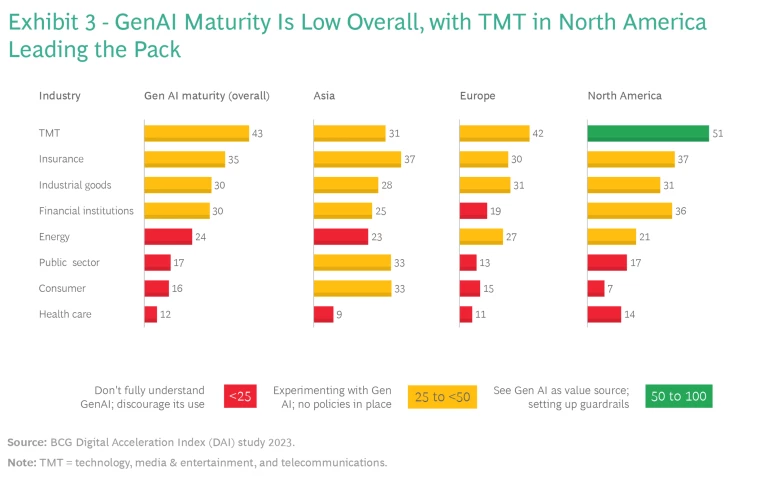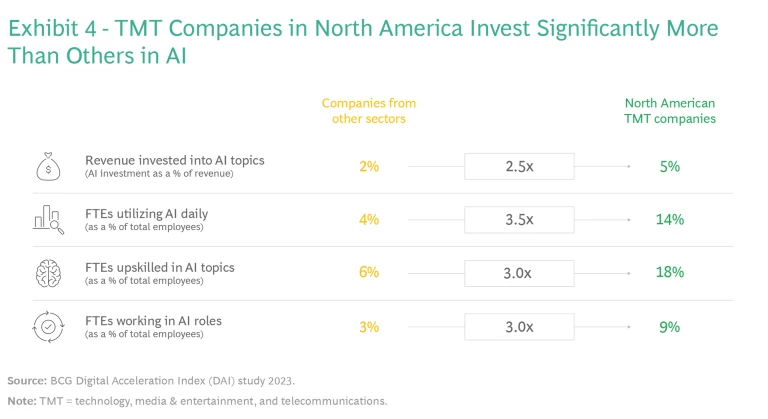We are in the early, heady days of generative AI. The potential seems boundless, and executives across industries are under pressure to incorporate GenAI into operations and capture benefits. By some estimates, GenAI could amplify global GDP by 7% and double productivity growth over the next decade. But will these rosy estimates actually become reality?
It’s a question worth asking because there are still a lot of divisions and skepticism in the executive ranks—not just between companies but within companies. According to a BCG survey of 2,000 global executives, based on BCG’s Digital Acceleration Index, more than 50% still discourage GenAI adoption. (See Exhibit 1.)

So, what’s going on here? To figure out what’s holding them back, we did a deep dive into leaders’ top concerns and challenges. (See the sidebar.) It turns out they are deeply worried about the practicality and implications of incorporating GenAI into their operations: limited traceability, potentially poor decision making, investment priorities, data security, and lack of skills.
Our Methodology
Of course, caution is warranted with any new technology—but inaction is not. As part of our survey, we looked closely at the practices of leading adopters and zeroed in on critical questions that all executives should ask as they plot their paths forward.
GenAI Concerns and Challenges
According to a July 2023 report from Goldman Sachs, GenAI could raise productivity by 1.5 percentage points after ten years of broad adoption, which would roughly double the recent pace of US productivity growth. But before that can happen, a majority of executives will need to overcome some major stumbling blocks (see Exhibit 2).

Concerns. One of their biggest concerns (more than 80% of respondents) is the technology itself. There are deep apprehensions about the limited traceability and irreproducibility of GenAI outcomes, raising the possibility of bad or even illegal decision making.
These are substantial issues. But there are ways to mitigate them. For example, meticulous recording of data sources, preprocessing steps, algorithm configurations, and model outputs could help establish transparency. And limiting the GenAI solution to using specific data sets would help improve reproducibility.
There are deep apprehensions about the limited traceability and irreproducibility of GenAI outcomes.
Another critical concern is data security and unauthorized access. “We’re worried that GenAI could compromise our customer information,” said the director of risk at a utility company. Implementing robust data encryption and access controls would be a way to address these worries. At the same time, companies should put in place clear guardrails that can be applied to GenAI. It’s also vital to train employees to foster a culture of security awareness.
Challenges. More than 80% of respondents cited the lack of a strategic roadmap (including investment priorities) and governance as major challenges. To overcome these hurdles, they need to align GenAI objectives with overarching business goals and establish a strong governance framework with clear roles and responsibilities. This will not only ensure ethical compliance and risk mitigation but also foster a culture of accountability.
Another significant challenge is the scarcity of talent—employees both proficient in AI and with specific domain expertise. More than 70% of the respondents who are hesitant to implement GenAI cite this issue. “We lack access to the right set of skills—not only technical, but also skills associated with implementing the use cases; for example, legal, data privacy, and compliance,” said a director of commercial and IT at a pharmaceutical company.
It is thus key to up- and reskill people and to encourage them to experiment and take risks. Another way to boost skills is to place people in cross-functional teams with end-to-end responsibility for a product. Companies can leverage external talent ecosystems and team up with other players in the market to fill remaining gaps.
Our survey also uncovered valuable information about what executives were not so worried about. For example, most leaders are relatively optimistic about Gen AI’s ROI potential and their ability to fund their company’s GenAI journey. If they are right, they have even more incentive to tackle their challenges and concerns. Respondents also seem fairly confident in the quality and availability of the data that will underpin and enable GenAI. Interestingly, the leaders we surveyed were not at all concerned about potentially increasing their carbon footprint when employing energy-intensive technologies such as GenAI.
Trailblazing the Path to GenAI Maturity
For clues about how to address these concerns and challenges, we looked at a select group of early pioneers moving quickly to develop GenAI expertise. Many of these organizations are in the technology, media and entertainment, and telecommunications (TMT) industry, and most are in North America, where the convergence of innovation and investment has created fertile ground for trailblazing initiatives (see Exhibit 3).

A closer examination of their strategies reveals four distinct areas of focus that have helped these companies advance their GenAI maturity:
- Startup Investment and Incubation. Pioneering organizations are taking proactive steps to incubate GenAI innovation. For example, Salesforce's launch of a $500 million GenAI fund illustrates its commitment to nurturing startups such as Anthropic and Cohere, which build large language models and focus on enterprise applications, GenAI safety, and the ability to handle larger context windows. Comcast, another TMT leader, invested in Hume AI, a GenAI startup focused on human emotional expression.
- Strategic Partnerships. Collaborative partnerships are a hallmark of GenAI pioneers. For instance, Zoom has joined forces with Anthropic to enhance its contact center platform with virtual agent capabilities. ServiceNow has aligned with Microsoft and OpenAI to amplify the capabilities of its Now Platform. By harnessing the synergies of strategic alliances, these pioneers are elevating the reach and impact of GenAI across sectors.
- Building New Capabilities. The integration of GenAI capabilities into existing offerings is a key strategy for these pioneers. Palo Alto Networks, a cybersecurity leader, is incorporating GenAI capabilities to enhance its threat detection and prevention solutions. Meanwhile, BuzzFeed’s launch of Infinity Quizzes, powered by GenAI, exemplifies how media organizations can leverage the technology to create personalized and engaging content.
The integration of GenAI capabilities into existing offerings is a key strategy.
- Hiring and Upskilling Initiatives. Pioneering organizations recognize the critical role of talent and are actively upskilling, hiring, and acquiring new AI skills. They have over three times more full-time employees using AI on a daily basis than other companies (see Exhibit 4); AT&T, for example, launched an internal GenAI assistance program for employees to enhance creativity and effectiveness. And, underscoring the intense battle for talent, the right people across companies are now commanding salaries of $900,000 or more.

Asking the Right Questions About GenAI
Yet while leading companies are already leveraging GenAI as a source of business value, there is no single roadmap for implementing it. As the chief revenue officer of an energy company put it: “Our biggest concern is not understanding the full implication of GenAI for our business, which has been very slow to respond to technological changes.”
With this in mind, we believe the journey requires that those in the C-suite ask themselves the right questions—questions that will shape the strategic direction and set the course for a future of innovation, resilience, and success.
How disruptive will GenAI be to our business? GenAI is not just a tool; it's a paradigm shift. Leaders must try to imagine the strategic landscape beyond the horizon. How rapidly will the industry change, and have any new entrants achieved scale? What new growth avenues does GenAI present? How can we design the organization to tap into unexplored markets, deliver unparalleled customer experiences, and revolutionize the value proposition? While the main GenAI investment areas are currently customer experience and product and service innovation (accounting for more than 80% of total use cases), the potential in Ops is also very promising.
GenAI is not just a tool; it's a paradigm shift. Leaders must try to imagine the strategic landscape beyond the horizon.
How can we capture "quick wins" in the near term? In the business world, every moment counts. The C-suite must identify the low-hanging fruit—the areas where GenAI can deliver quick wins. How can it streamline manual and other mentally draining processes to boost productivity? What touchpoints can we embed GenAI into to delight customers? How do we identify the use cases for quick wins and prioritize them? Such wins, though often small, can yield outsized impact, boosting morale, building momentum, and showcasing the tangible value of GenAI to stakeholders. By capturing them, executives not only demonstrate the efficacy of GenAI but also build a culture of innovation and adaptability that will serve as the bedrock for future transformations.
How can we rapidly and effectively build GenAI capabilities throughout the organization? GenAI's potential will permeate many facets of the organization. To capitalize on this potential, the C-suite must engineer the rapid acquisition of certain capabilities. How can the company give teams the skills, knowledge, and tools needed to integrate GenAI seamlessly into their workflows? How can we foster cross-functional collaboration, breaking down silos and enabling diverse expertise to coalesce around GenAI initiatives? The ability to democratize GenAI capabilities across the organization is critical to achieving greater GenAI maturity.
Given the very real concerns and challenges GenAI raises, the fact that 50% of executives still regard it with some trepidation and even discourage its use is not surprising. But make no mistake: GenAI is not a fleeting trend and will demand a reimagining of possibilities and a recalibration of strategies. As leaders come to grips with this technology, they have the opportunity to shape a legacy that will resonate far into the future.
The authors would like to thank Michael Leyh and Marc Roman Franke for their valuable contributions to this article.







